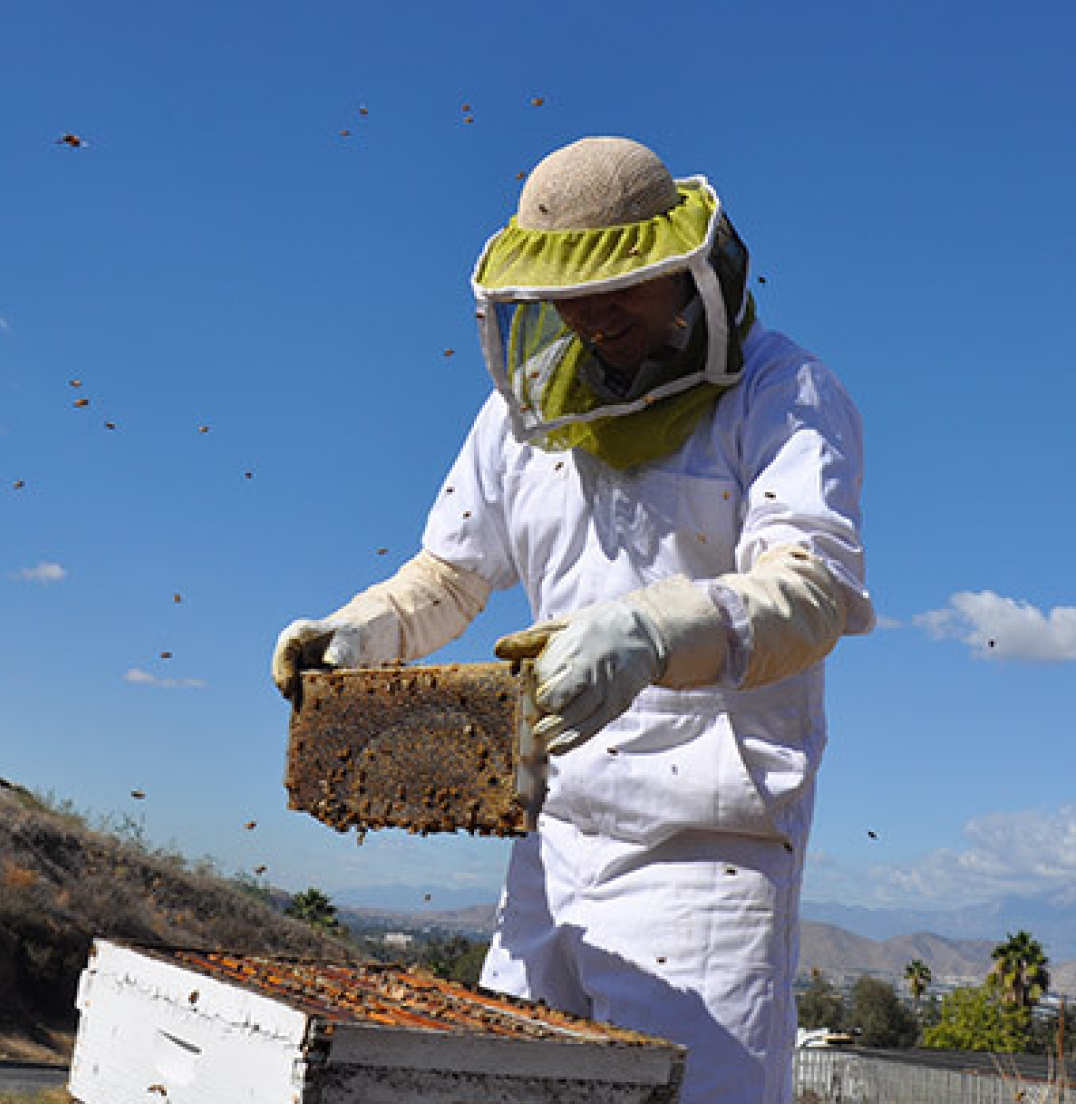Summary
My group studies the interactions of microorganisms with their environment, each other, and host organisms. This includes the study of parasites and symbionts, and their interactions with anthropogenic actions such as agrochemical exposure and climate change.
Much of our research is focused on the parasites and wider microbial community (microbiome) that live within, and transmit between, different bee species.

Dr Peter Graystock inspecting the honeybee hives in Riverside, California, USA
Working with governing bodies (Natural England), conservation bodies (Bumblebee Conservation Trust) and industry leaders (Biobest), this research has been influential in improving managed bee rearing practices and wild bee health.
These findings on managed bumblebees and parasite transmission have informed both conservation and policy, prompting recognition by NERC in their inaugural impact awards.
Recent research has demonstrated that flowers can act as transmission hubs for microbes between bee species, which has become foundational to several research strands; including, research into how being choosy about the flowers they visit may influence the risk of a bee catching a particular disease.
Lab News
- We start the year with an early conference talk - Ryan presented his Masters research on bumblebee population genetics at the UK Population Genetics Group conference
- Our work on European foul brood is of great interest and Monika was invited to the UK Bee Health Advisory Forum to discuss the ongoing EFB work from her PhD and the lab.
- Publication! as part of a European collaboration we published work in Scientific Reports showing the results of screening bees from across Europe for viruses. We find climate and honeybees are linked to virus prevalence in wild bees
- Spring harvest - We took a spring honey harvest this year to help prepare our research hives for some experiments we have planned this year on their brood. A tasty bit of research prep!
- The Graystock and Gill groups shared a tent at the Great Exhibition road festival in South Kensington. Together with the Bumblebee Conservation Trust, The Butterfly Trust, and the Seedball company we spoke to the public about the value of pollinators and gave hands-on workshops on making your own seedballs!
- Monika presented work on EFB disease and pesticide exposure to the IUSSI conference in San Diego, USA.
- Publication! Monika published the first manuscript from her PhD, reviewing the risks posed by disease and pesticides to bee larvae.
- The lab held stalls at the Silwood park Bees, Birds and Beasts day where we showed off our honey bees and bumblebees to visitors and discussed our ongoing research
- Monika received full funding to attend the 2-week SymbNet PhD workshop in Portugal to learn about recent discoveries and advancements in symbiosis research.
More details
Visit www.graystock.info for more details of the groups research activities
Publications
Journals
Kenna D, Graystock P, Gill R, 2023, Toxic temperatures: bee behaviours exhibit divergent pesticide toxicity relationships with warming, Global Change Biology, Vol:29, ISSN:1354-1013, Pages:2981-2998
Yordanova M, Evison SEF, Gill RJ, et al., 2022, The threat of pesticide and disease co-exposure to managed and wild bee larvae, International Journal for Parasitology: Parasites and Wildlife, Vol:17, ISSN:2213-2244, Pages:319-326
Piot N, Schweiger O, Meeus I, et al., 2022, Honey bees and climate explain viral prevalence in wild bee communities on a continental scale, Scientific Reports, Vol:12, ISSN:2045-2322
Rothman JA, Russell KA, Leger L, et al., 2020, The direct and indirect effects of environmental toxicants on the health of bumblebees and their microbiomes, Proceedings of the Royal Society B-biological Sciences, Vol:287, ISSN:0962-8452
Figueroa LL, Grab H, Ng WH, et al., 2020, Landscape simplification shapes pathogen prevalence in plant-pollinator networks, Ecology Letters, Vol:23, ISSN:1461-023X, Pages:1212-1222


